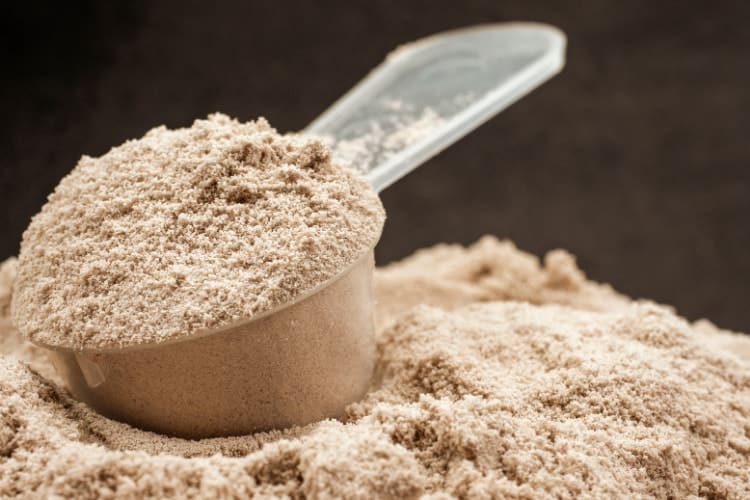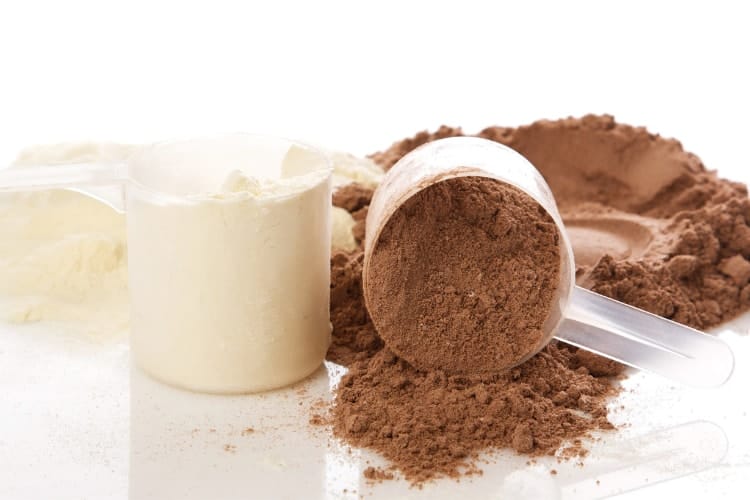
For many women, whey protein powder is an easy and convenient way of getting more protein into their diet. However, as hormonal imbalances become more widespread, and as more people become aware of the use of growth hormones on farms, there are concerns about the potential link between whey protein and estrogen dominance.
So, in this article, we’re going to take a closer look at what’s going on with whey and our hormones. More specifically we will dive into:
- the estrogen content of whey protein.
- whey’s effects on estrogen levels.
- things to look out for when choosing a whey powder.
- alternatives to whey protein powder.
Note: this post contains affiliate links and I earn a commission (at no additional cost to you) if you use them to make a purchase.
IS WHEY PROTEIN HIGH IN ESTROGEN?
Since whey protein comes from cow’s milk, it does contain estrogen. The estrogen comes mainly from the estradiol that is naturally found in cows, as well as soy phytoestrogens (since cows are usually fed soy). Overall, whey powders have lower amounts of estrogen in comparison to other powders like soy, which is naturally richer in estrogen (source).
However, even though the levels of estrogen are generally low, it’s important to remember that each person’s body is different. Those “small” amounts of estrogen could still have an undesired effect if whey powder is used for a long period of time.
DOES WHEY PROTEIN AFFECT ESTROGEN?

There is conflicting information regarding the effect of whey protein on estrogen. On the one hand, research suggests that whey protein may lower estrogen production. But on the other hand, the smaller amounts of estrogen in whey powders, combined with whey’s effects on the digestive system, could negatively affect estrogen.
Now, one thing to note is that the study that showed a reduction in estrogen was done with men. So, we don’t know for sure if the same estrogen-lowering effects would occur in women (and that wouldn’t be good because too little estrogen will create other issues).
As for whey’s effects on the digestive system, it could potentially contribute to high estrogen levels because:
- Research shows that many commercial protein powders contain heavy metals and BPA (a component of plastic that has estrogenic effects). In fact, the research showed that the amount of BPA can be as high as 25 times the allowable limit. With that much toxins, that means the liver has to work harder to get rid of those toxins. If the liver isn’t in good health, then those toxins could accumulate and contribute to estrogen dominance.
- The body is having a hard time digesting the whey. Whey is highly processed and depending on the brand, the powder can have additives that trigger gut inflammation. And unfortunately, inflammation in the gut can make it more difficult for the body to properly regulate estrogen production and metabolism.
CAN WHEY PROTEIN AFFECT YOUR PERIOD?
Depending on the quality, whey protein can contain estrogen, heavy metals and other toxins that contribute to inflammation and hormonal imbalance. Since the menstrual cycle is regulated by hormones, regular consumption of low quality whey protein could negatively affect the menstrual cycle.
For a deeper dive into this topic, be sure to read this article on protein powder and the menstrual cycle.
It provides more information on how protein powders are made, their true nutritional value and tips on how to use them wisely.
HOW TO CHOOSE A GOOD QUALITY WHEY POWDER
Technically speaking, all whey protein will always contain small amounts of estrogens (i.e. the natural estrogen that the cow produces). Nonetheless, there are steps that you can take to choose a good quality whey powder that is low in synthetic/added estrogen and other toxins.
Reducing your exposure to these chemicals is essential for minimizing any harmful effects that the powder can have on your hormones.
So, when purchasing whey powder, look for one that is:
- Made from 100% grass-fed cows.
- Hormone, pesticide and antibiotic-free.
- Organic (or at least non GMO).
- Free of added sugar (this includes things like maltodextrin and sugar alcohols like sorbitol, which can be inflammatory for some people).
- Gluten-free (even if you don’t have celiac disease, gluten-containing additives can potentially trigger inflammation for some people).
- An “isolate,” not a concentrate. Whey isolate has less lactose than whey concentrate. Less lactose means less pro-inflammatory compounds.
One powder that I suggest using is this one from Opportuniteas. It’s a non-GMO, hormone-free whey isolate that comes from grass-fed cows. In addition there are just two ingredients in this powder:
- whey protein (approximately 99%)
- sunflower lecithin (approximately 1%) to help the powder dissolve easily without clumping.
ESTROGEN-FREE PROTEIN POWDER (WHEY ALTERNATIVES)

If you’d rather avoid whey protein and altogether, then the best thing to do is to use a plant-based protein powder made from things like:
- peas
- hemp
- rice
- seeds (chia or pumpkin, for example)
- quinoa
- amaranth
When choosing your powder you want to favor ingredients like peas, hemp and quinoa because they are complete proteins. This means that they contain all the essential amino acids that the body needs.
That said, please be aware that the amounts of individual amino acids in these plant proteins is going to vary when compared to whey.
However, remember that protein powder is only meant to supplement your diet. It’s not intended to be a substitute for a well rounded diet.
So, as long as you’re eating a diet that incorporates other whole food sources of protein, you can still get sufficient amounts of the amino acids that you need.
Lastly, to ensure that your protein powder is truly estrogen-free:
- read the ingredients to ensure that there’s no soy.
- buy organic because pesticides have an estrogenic effect.
One brand that checks all the boxes is Plat Vital. Their powder is organic and contains peas, rice, spirulina, pumpkin seeds and chia seeds. In addition, there are fruits and veggies like strawberries, kale, apples and more to boost the nutritional content.
This is definitely one of the cleanest protein powders on the market and you can get yours here on Amazon.
RELATED QUESTIONS ABOUT WHEY PROTEIN AND HIGH ESTROGEN
What are the side effects of too much whey protein?
Consuming too much whey protein can cause digestive issues such as bloating, diarrhea, gas and cramps. In addition, too much whey could also cause headaches and fatigue (source).
Is it bad to drink two protein shakes a day?
While you can drink two shakes from time to time, making it a regular thing could create other problems. The main concern here is that the more protein shakes you drink per day, then the less whole food sources of protein you’re consuming.
Remember outside of their protein content, protein powders generally do not provide other nutrients. Whereas whole food sources of protein – such as beans – also contain fiber, antioxidants, magnesium, iron, folate and many other nutrients.
So, every time you drink a protein shake instead of consuming a whole food source of protein, that means you’re also missing out on all those other nutrients. Long-term, this could lead to deficiencies and imbalances in the body.
CONCLUSION
Although whey protein can be used as a supplementary source of protein, it could have a significant impact on estrogen levels and the menstrual cycle.
So, you’re better off replacing it with plant sources of protein.
Do keep in mind that you can get all the protein you need from your diet. Protein powders are not a must-have.

Related Posts:
Best Protein Powder For Hormonal Balance: Top Brands and What to Look For
Symptoms of Estrogen Dominance: Top Causes And How To Find Balance
How To Eliminate Estrogen Dominance Naturally and Confidently
How To Use Adaptogens for Estrogen Dominance Relief


